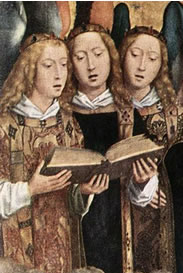Hymn Singing at Mass
By Haig Mardirosian
A ROBUST CULTURE of congregational song is a hallmark of Christian worship. Present day Christianity, especially in the English-speaking world, is notable for the shared tradition of hymnody. In a pluralistic age, that comprises a remarkable witness to the oneness of the Church. Hymns, even within the stylistically circumscribed practice of our Parish, come from every corner of the Church's history. They derive from plainsong, from secular folk melodies, from pre and post-Reformation vernacular devotional song. Hymns have roots as far back as the middle ages, and continue to be composed today.
Nothing indicates the health of a parish better than the vigour of its communal worship as manifested in the singing of the whole community. Here are some reminders on being a better performer in the pews.
Sit with your friends
Singing in a large church such as ours can be a lonely experience unless we support each other. Please consider sitting in the middle nave rather than the side aisles. By gathering with our family and friends we not only support our singing, but transform a large and empty room into a smaller and fuller place. Sitting closer together also welcomes visitors more warmly
Follow the organ when singing hymns
The organ is the traditional leading voice for congregational song. Unlike the practice in some places, namely Roman Catholic and Evangelical churches, our cantors do not function primarily in the capacity of "facilitators of song." They do not stand before us and beckon us to sing. While our cantors do sing everything that we sing in the pews, their primary contribution is that of the "psalmist," singing the verses of the minor proper in the absence of the choir.
Observe our custom on part singing
Where hymns are reproduced in parts, the invitation to sing them in parts if you wish is implicit. However, with some exceptions, our custom is to sing the opening and final verses in unison. Notice, when the choir returns from its holiday, that they observe this practice as well.
The liturgical place and priority of hymns cannot be overestimated. Hymn singing is not an excuse for hearing "old favourite" music in church. Hymns, like the minor proper, and choral anthems and motets, are integral pieces of the liturgical mosaic. Each is a text that accompanies or reflects on rite. While we omit nothing, thereby singing propers, motets and hymns (as in the case of the offertory or the communion, or both a hymn and an introit at the entrance) mostly in the interests of filling the time required for deliberate and solemn liturgical ceremony, any one of the texts bears liturgical significance and completeness. So, just as the voices of the schola chant the text of the minor proper, the choir sings an anthem or motet, we all sing the hymn. All these three carry their own important liturgical weight.
Hymn
"A derivative of the Latin hymnus, which comes from the Greek hymnos, derived from hydein, to sing. In ancient pagan literature hymnos designates a prize song to the gods or heroes Set to the accompaniment of the cythara (hymnoi men es tous theous poiountai, epainoi d'es anthropous, Arrian., IV, xi), at first written in the epic measure like the oldest hymn to the Delphic Apollo, later in distichs or in the refined lyric measures of Alcæus, Anacreon, and Pindar. In Christian literature the noun hymnos occurs in only two passages in the New Testament, namely Eph., v, 19, and Col., iii, 16, and then together with the synonyms psalmos and ode pneumatike. With these can be compared the verb hymnein in Matthew 26:30; Mark 14:26; Acts 16:25; and Hebrews 2:12. Notwithstanding the many attempts at definitions made by exegetes it is difficult to decide to what degree, if at all, a distinction among three kinds of Divine praises is made by the three different terms, psalms, hymns, and spiritual canticles." >> Read more>>

